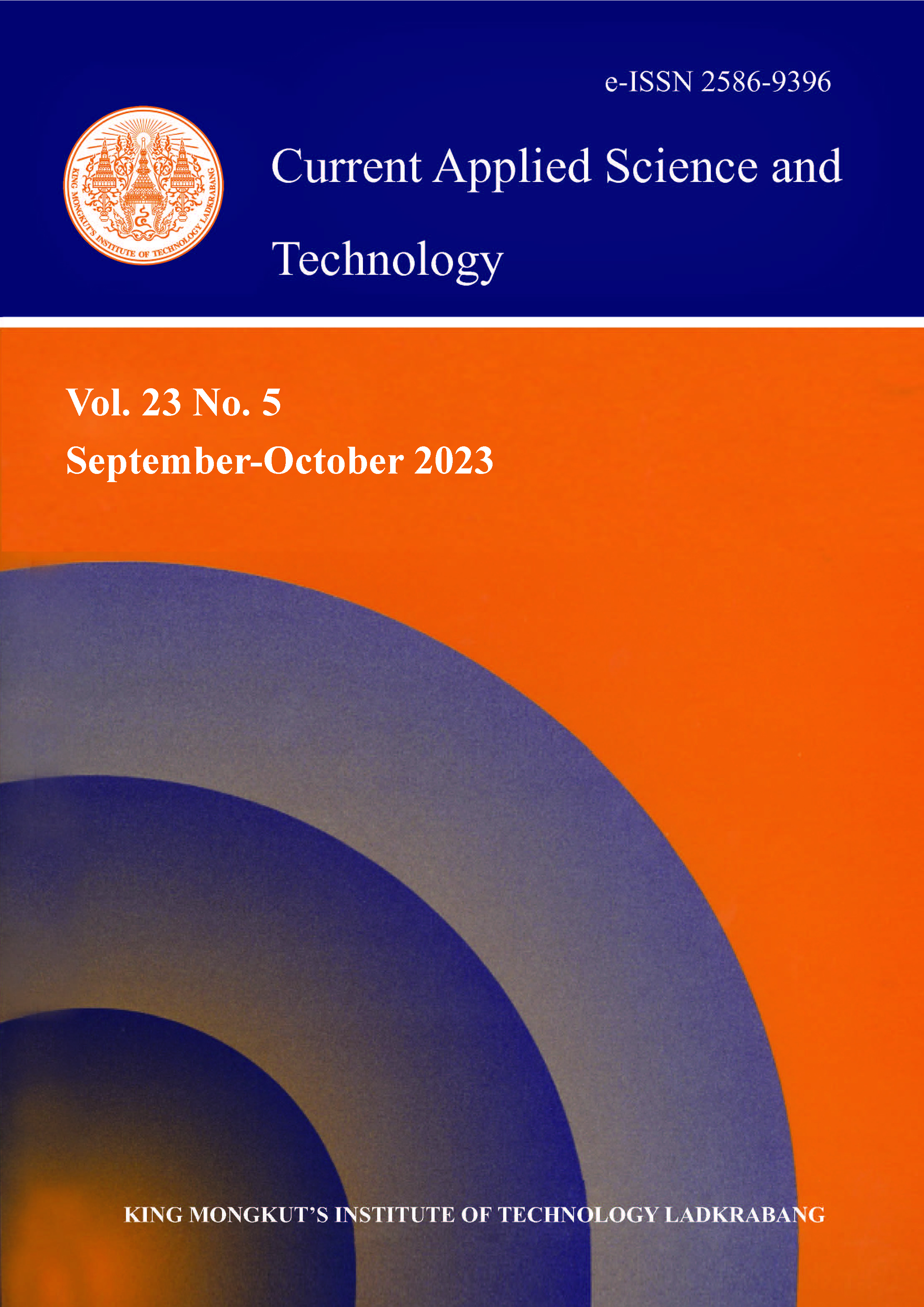Multi Self-cleaning Properties of Zinc Oxide Nanoparticles/ Polydimethylsiloxane (ZnO/PDMS) Composite on Polyester Textile
Main Article Content
Abstract
Self-cleaning textiles can be divided into three categories, which are the physical, chemical, and biological self-cleaning types. Physical self-cleaning refers to the lotus effect, which relates to the hydrophobic properties of the textile. Chemical self-cleaning is the degradation of color stains, discolored solutions and other organic species that come into contact with textiles. The last is biological self-cleaning, which is the ability to kill bacteria that become attached to the textiles. In this research, the development of all three self-cleaning properties of polyester textile coated with zinc oxide nanoparticles/ polydimethylsiloxane (ZnO/ PDMS) composite was focused. The ZnO nanoparticles were synthesized by a hydrothermal process, which involved blending PDMS with various concentrations of ZnO nanoparticles. The polyester textile was coated with ZnO/ PDMS composite solution via a dip coating technique done with various dipping times. The lotus effect, which depends on hydrophobic properties, was analyzed by water contact angle measurement. The chemical self-cleaning of the polyester textile was examined by photocatalytic methylene blue dye degradation with UV-Vis spectrometry. The inhibition zone of antibacterial activity was tested via disc diffusion technique. From these results, it was found that the polyester textile coated with ZnO/PDMS composite demonstrated all self-cleaning properties, physical, chemical and biological, in a significantly way.
Keywords: self-cleaning; ZnO/PDMS; polyester; textile; composite
*Corresponding author: Tel.: (+66) 840996582
E-mail: wantana.k@sci.kmutnb.ac.th
Article Details

This work is licensed under a Creative Commons Attribution-NonCommercial-NoDerivatives 4.0 International License.
Copyright Transfer Statement
The copyright of this article is transferred to Current Applied Science and Technology journal with effect if and when the article is accepted for publication. The copyright transfer covers the exclusive right to reproduce and distribute the article, including reprints, translations, photographic reproductions, electronic form (offline, online) or any other reproductions of similar nature.
The author warrants that this contribution is original and that he/she has full power to make this grant. The author signs for and accepts responsibility for releasing this material on behalf of any and all co-authors.
Here is the link for download: Copyright transfer form.pdf
References
Gautam, B. and Yu, H.-H., 2020. Self-cleaning cotton obtained after grafting thermoresponsive poly(N-vinylcaprolactam) through surface-initiated atom transfer radical polymerization. Polymers, 12(12), DOI: 10.3390/polym12122920.
Tung, W.S. and Daoud, W.A., 2011. Self-cleaning fibers via nanotechnology: A virtual reality. Journal of Materials Chemistry, 21(22), 7858-7869, DOI: 10.1039/C0JM03856C.
Afzal, S., Daoud, W.A. and Langford, S.J., 2014. Superhydrophobic and photocatalytic self-cleaning cotton. Journal of Materials Chemistry A, 2(42), 18005-18011, DOI: 10.1039/C4TA02764G.
Jeong, E., Woo, H., Moon, Y., Lee, D.Y., Jung, M., Lee, Y. and Bae, J., 2021. Self-cleaning polyester fabric prepared with TiOF2 and hexadecyltrimethoxysilane. Polymers, 13(3), DOI: 10.3390/polym13030387.
Ashraf, M., Champagne, P., Campagne, C., Perwuelz, A., Dumont, F. and Leriche, A., 2014. Study the multi self-cleaning characteristics of ZnO nanorods functionalized polyester fabric. Journal of Industrial Textiles, 45(6), 1440-1456, DOI: 10.1177/1528083714562086.
Leng, B., Shao, Z., With, G. and Ming, W., 2009. Superoleophobic cotton textiles. Langmuir, 25(4), 2456-2460, DOI: 10.1021/la8031144.
Xue, C-H., Jia, S-T., Zhang, J. and Tian, L-Q., 2009. Superhydrophobic surfaces on cotton textiles by complex coating of silica nanoparticles and hydrophobization. Thin Solid Films, 517(16), 4593-4598, DOI: 10.1016/j.tsf.2009.03.185.
Wu, D., Long, M., Zhou, J. and Cai, W., 2009. Synthesis and characterization of self-cleaning cotton fabrics modified by TiO2 through a facile approach. Surface and Coatings Technology, 203(24), 3728-3733, DOI: 10.1016/j.surfcoat.2009.06.008.
Son, Y-A. and Sun, G., 2003. Durable antimicrobial nylon 66 fabrics: Ionic interactions with quaternary ammonium salts. Journal of Applied Polymer Science, 90(8), 2194-2199, DOI: 10.1002/app.12876.
Kwak, G., Jung, S. and Yong, K., 2011. Multi-functional transparent ZnO nanorod films. Journal of Nanotechnology, 22 (11), DOI: 10.1088/0957-4484/22/11/115705.
Cao, Z., Zhang, Z., Wang, F. and Wang, G., 2009. Synthesis and UV shielding properties of zinc oxide ultrafine particles modified with silica and trimethylsiloxane. Colloids and Surfaces A: Physicochemical and Engineering Aspects, 340 (1-3), 161-167, DOI: 10.1016/j.colsurfa.2009.03.024.
Nourbakhsh, S., 2021. Self-cleaning and antibacterial properties of ZnO nanoparticles on cotton fabric treated with maleic acid. Materials Science (Medžiagotyra), 27(1), 90-95, DOI: 10.5755/j02.ms.24745.
AbdElhady, M.M., 2012. Preparation and characterization of chitosan/zinc oxide nanoparticles for imparting antimicrobial and UV protection to cotton fabric. International Journal of Carbohydrate Chemistry, 2012, DOI: 10.1155/2012/840591.
Hassan, MS., 2003. Microbial detection, surface morphology, and thermal stability of cotton and cotton/polyester fabrics treated with antimicrobial formulations by a radiation method. Journal of Applied Polymer Science, 89, 2604-2610, DOI: 10.1002/app.12472.
Vigneshwaran, N., Kumar, S., Kathe, A.A., Varadarajan, P.V. and Prasad, V., 2006. Functional finishing of cotton fabrics using zinc oxide-soluble starch nanocomposites. Nanotechnology 17, 5087-5095, DOI: 10.1088/0957-4484/17/20/008.
Rajendran, R., Balakumar, C., Ahammed, H.A., Jayakumar, S., Vaideki, K. and Rajesh, E.M., 2010. Use of zinc oxide nanoparticles for production of antimicrobial textiles. International Journal of Engineering, Science and Technology, 2(1), 202-208, DOI: 10.4314/ijest.v2i1.59113.
Li, Q., Chen, S. and Jiang, W., 2007. Durability of nano ZnO antibacterial cotton fabric to sweat. Journal of Applied Polymer Science, 103, 412-416, DOI: 10.1002/app.24866.
Sethy, N.K., Arif, Z., Mishra, P.K. and Kumar, P., 2020. Nanocomposite film with green synthesized TiO2 nanoparticles and hydrophobic polydimethylsiloxane polymer: synthesis, characterization, and antibacterial test. Journal of Polymer Engineering, 40(3), 211-220, DOI: 10.1515/polyeng-2019-0257.
Kim, M.G., Lee, J.E., Kim, K.S., Kang, J.M., Lee, J.H., Kim, K.H., Cho, M. and Lee, S.G., 2021. Photocatalytic degradation of methylene blue under UV and visible light by brookite–rutile bi-crystalline phase of TiO2. New Journal of Chemistry, 45(7), 3485-3497, DOI: 10.1039/d0nj05162d.
Zuo, R., Du, G., Zhang, W., Liu, L., Liu, Y., Mei, L. and Li, Z., 2014. Photocatalytic degradation of methylene blue using TiO2 impregnated diatomite. Advances in Materials Science and Engineering, 2014, DOI: 10.1155/2014/170148.
Narath, S., Koroth, S.K., Shankar, S.S., George, B., Mutta, V., Wacławek, S., Černík, M., Padil,V.V.T. and Varma, R.S., 2021. Cinnamomum tamala leaf extract stabilized zinc oxide nanoparticles: A promising photocatalyst for methylene blue degradation. Nanomaterials, 11, DOI: 10.3390/nano11061558.






